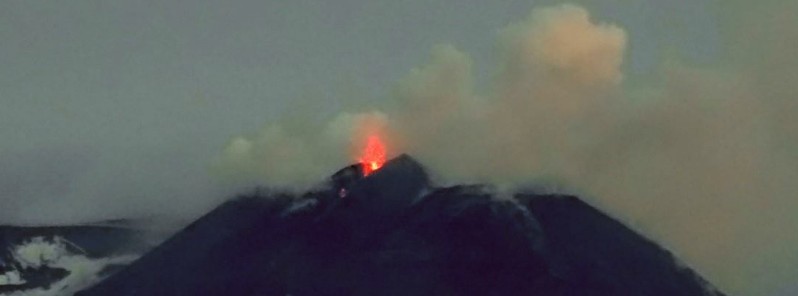Activity at Mount Etna spreading to all craters, Italy

Following an increase in Strombolian activity on February 27, 2017, Mount Etna, Europe's largest volcano, continues erupting and it appears the activity is now spreading to all the craters at the top of the mountain.
INGV reported that Strombolian activity at Etna’s New Southeast Crater (NSEC) cone had gradually intensified beginning at 16:00 UTC on February 27. Lava soon overflowed the vent, quickly traveled down the S flank, and then slowed after reaching the gently sloping terrain. The flow spread SSW, towards the old cone of Monte Frumento Supino.
Frequent Strombolian explosions ejected incandescent lava fragments up to 200 m (656 feet) above the vent. INGV-Osservatorio Etneo staff observed sporadic emissions of vapor and brownish ash from several vents within the NSEC. A new pyroclastic cone around the vent had grown higher than the highest points on the SEC (Southeast Crater) or NSEC. The lava flow slowly advanced on top of the snow, and by March 1 was about 1.5 km (0.9 miles) from the vent. By the late evening, activity declined, and the volcanic tremor amplitude rapidly diminished.
However, the activity at the volcano continued and now it appears it is spreading to all craters.
As of early March 15, the volcanic tremor amplitude is sharply rising.
Geological summary
Mount Etna, towering above Catania, Sicily's second largest city, has one of the world's longest documented records of historical volcanism, dating back to 1500 BCE. Historical lava flows of basaltic composition cover much of the surface of this massive volcano, whose edifice is the highest and most voluminous in Italy. The Mongibello stratovolcano, truncated by several small calderas, was constructed during the late Pleistocene and Holocene over an older shield volcano. The most prominent morphological feature of Etna is the Valle del Bove, a 5 x 10 km (16 404 x 32 808 feet)horseshoe-shaped caldera open to the east.
Two styles of eruptive activity typically occur at Etna. Persistent explosive eruptions, sometimes with minor lava emissions, take place from one or more of the three prominent summit craters, the Central Crater, NE Crater, and SE Crater (the latter formed in 1978). Flank vents, typically with higher effusion rates, are less frequently active and originate from fissures that open progressively downward from near the summit (usually accompanied by strombolian eruptions at the upper end). Cinder cones are commonly constructed over the vents of lower-flank lava flows. Lava flows extend to the foot of the volcano on all sides and have reached the sea over a broad area on the SE flank. (GVP)
Featured image credit: Eruption at Mount Etna, Italy on the morning of March 15, 2017. Credit: Boris Behncke

Mamma Mia and Papa Giuseppe! She a gonna blow like a da honeymooner nuts!
She a gonna blow a big time! Sicily, she shoulda evacuate to a mainland.
If this were happening on Mount St. Helens (USA) the area around would be evacuated to a distance of perhaps 50 miles or 80+ Kilometers.